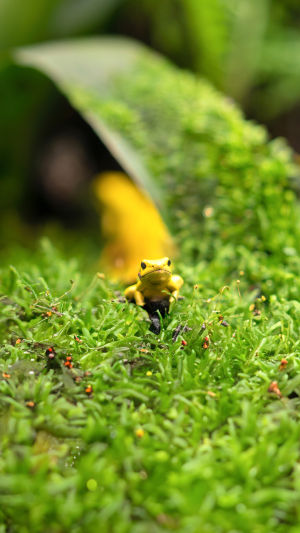Lykkers, the South American rainforest is home to one of nature's most stunning sights: the poison dart frog. With their dazzling shades of blue, yellow, and red, these amphibians captivate anyone lucky enough to glimpse them.
However, these vivid hues serve a critical purpose.
They are not merely decorations; they signal that these small creatures possess potent toxins, making them perilous to touch or consume. When encountered, these striking frogs can cause nausea, swelling, and even paralysis in humans, reminding observers that nature's beauty can be deceptively dangerous.
<h3>Beauty's Hidden Bite</h3>
Beneath the dazzling exterior of the poison dart frog lies a potent arsenal. Merely touching its skin can cause severe nausea, painful swelling, or even paralysis. These tiny amphibians pack enough toxin to deter most would-be attackers. Their vibrant appearance acts like a <b>neon billboard</b>, advertising their lethal nature.
Predators quickly learn that such eye-catching meals come with a terrible price.
<h3>An Evolutionary Puzzle</h3>
This raises a perplexing question. How did the first slightly colorful frog survive? If a mutant frog appeared with a bright patch, wouldn't hungry predators simply eat it before learning its taste was foul? This seeming paradox has long puzzled evolutionary biologists.
The answer lies not in sudden brilliance, but in a slow, cunning dance of adaptation called <b>aposematism</b>.
<h3>Gradual Warning Signs</h3>
Recent research, published in the prestigious journal <b>Science</b>, reveals these colors evolved step-by-step. It wasn't an overnight transformation. Early ancestors likely possessed subtle hints of warning tucked away. Imagine hidden splashes of color under legs or bellies, only revealed during close encounters.
This allowed predators a chance to learn the association – brightness equals badness – without dooming every colorful pioneer.
<h3>Learning the Hard Way</h3>
<b>Changku Kang</b>, a co-author of the study from Seoul National University, explains the critical point. A single, fully bright frog appearing in a drab population is likely doomed. Predators haven't learned the color code yet. Survival hinges on the predator experiencing the unpleasant consequence after seeing the color, forging the crucial mental link.
Hidden colors provide this vital learning opportunity safely.
<h3>Mapping Color's Journey</h3>
To solve this code, scientists analyzed over 1,000 amphibian species. They moved beyond simple conspicuous versus camouflaged labels. Instead, they identified five distinct groups, including crucial transitional forms.
These are species that masterfully blend camouflage with hidden warnings, representing the vital middle stages in the evolution of full <b>aposematism</b>.
<h3>Masters of Disguise</h3>
Consider the North American <b>rough-skinned newt</b> (Taricha granulosa). At first glance, its dull, cryptic brown skin offers perfect camouflage against the forest floor. But when threatened, it performs the "unken reflex." It arches its back, revealing a startlingly vibrant orange or yellow belly.
This sudden flash screams danger, startling the predator and providing a memorable lesson.
<h3>Hidden Reveals</h3>
Many amphibians use this "<b>flash coloration</b>" strategy. Frogs might have brightly colored inner thighs only visible when jumping. Salamanders may lift their tails to show vivid undersides. These concealed signals allow the animal to be inconspicuous most of the time, minimizing unnecessary attention.
The warning only blazes forth when absolutely needed, maximizing its impact.
<h3>Path to Prominence</h3>
The researchers constructed intricate evolutionary trees and tested nine different models. Their findings were clear. The path to today's dazzling frogs was indirect. Ancestors relied heavily on camouflage. Gradually, partial conspicuousness – like hidden flashes – emerged.
Only later did full, permanent <b>aposematic coloration</b> evolve across different amphibian families, becoming the widespread warning system we see now.
<h3>Teaching Predators</h3>
This gradual shift was essential. By initially hiding their <b>chemical defenses</b> behind cryptic looks, amphibians controlled the teaching moment. When a predator got too close, the sudden reveal of color coincided with the awful taste or toxic effect.
This created a powerful, unforgettable association in the predator's mind, paving the way for future generations to be boldly bright.
<h3>Beyond Simple Camouflage</h3>
Zoologist Alice Exnerová highlights the importance of these findings. Understanding these alternative strategies reveals nature's incredible ingenuity. Defense isn't just about hiding or screaming danger; it's a spectrum.
Recognizing these <b>intermediate adaptations</b> deepens our appreciation for the complex evolutionary pressures shaping survival tactics.
<h3>Nature's Color Code</h3>
The story of the poison dart frog's color is more than skin deep. It's a testament to the slow, powerful force of <b>natural selection</b>. Through countless generations, subtle variations offered survival advantages. Hidden warnings became teaching tools. Camouflage slowly gave way to confident advertisement.
This intricate dance between prey and predator crafted one of nature's most visually stunning and effective defensive adaptations.
<h3>Conclusion</h3>
The vibrant hues of rainforest frogs are far more than decoration. They are the result of a million-year evolutionary journey, a sophisticated language of survival written in bold colors. From hidden flashes to full neon displays, these amphibians mastered the art of the warning.
Their story reminds us that nature's most dazzling spectacles often conceal the deepest strategies for enduring life's constant challenges.





